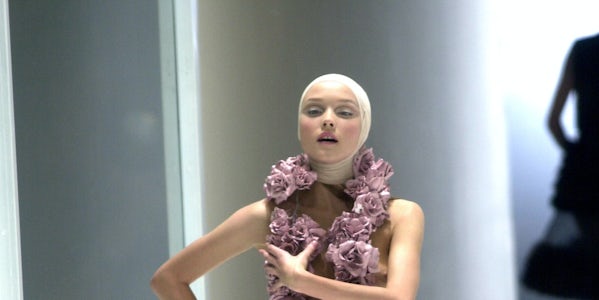Tim Blanks’ Top Fashion Shows of All-Time: Alexander McQueen Spring/Summer 2001, September 26, 2000 | Fashion Show Review, Tim Blanks’ Top Fashion Shows of All-Time
For the past six months, I’ve been choosing a weekly favourite from my 30-plus years of going to fashion shows. It seemed like an appropriate way to remember — to celebrate — something the industry was missing. But, as The Worst Year Ever™ comes to an end, I felt my choice should be a more pointed reminder of what once was. More than nostalgic uplift, more than wanton acts of beauty or provocation, what could — did — a fashion show offer? With that question in mind, a re-visit of Alexander McQueen’s Spring 2001 show had a pleasing inevitability.
Beauty and horror were the tentpoles of McQueen’s aesthetic. The quest for one, the flight from the other felt like mean motivators in 2020. So seeing those impulses crystallised so vividly on a fashion runway two decades ago confirms McQueen’s peculiar prescience. Except he flipped them. He was often seeking the beauty in horror, the horror in beauty. Hence this show, unfolding in a lunatic asylum, white-tiled floor, padded walls, one-way glass, institutional, observational…the audience could watch the inmates, just as they used to in Bedlam in London or Charenton in Paris, where the public would pay a fee to see.
But McQueen’s comment was less on those unenlightened times, more on the self-regard that flipped his wig in fashion. When we filed into the Gatliff Road depot, the godforsaken, gasoline-soaked cavern that Lee favoured as his venue in London till he relocated to Paris, we were confronted with a huge mirrored cube, centred on another smaller cube. And, when we took our seats, we were confronted again – by our own reflections. So we sat for an hour or so staring at ourselves, while a heartbeat pulsed on the soundtrack. I thought it was one of McQueen’s more memorable fuck-you’s. In a subsequent interview, he posed the question he obviously wanted everyone to be asking themselves that night: “Am I actually as good as what I’m looking at?”
Then the box lit up and Kate Moss reeled into the antiseptic show space, her body swathed in feathered chiffon, her head wrapped in bandages. Like a lobotomy patient, or like Baron de Meyer’s classic 1935 advertisement for Elizabeth Arden? Horror or beauty? She couldn’t see us but we could watch her every unhinged move. That tension was spectacularly teased out for the rest of the show.
It was enigmatically titled VOSS. If there’d been a search engine handy in those days, I would have quickly found out that Voss was a town in Norway, famous for its birdlife. McQueen loved birds. Flight, escape from confinement… but also Hitchcockian ambiguity. Beauty with beaks and claws. Jade Parfitt walked in a full skirt of feathers with a Philip Treacy headdress of taxidermied eagles in attack mode. Erin O’Connor closed the show in a full flurry of ostrich, dyed red and black and topped with a sheath of microscope slides, also dyed red, like the blood they would usually contain, but here with an almost feathery feel. A beautiful grotesque.
O’Connor also wore the showstopper, a full-length gown created with hundreds of razor clam shells, collected on a beach in Norfolk. Before she went on, McQueen whispered in her ear, “I want you to rip the dress off.” The ever-elegant O’Connor duly obliged by enacting the most dignified nervous breakdown, clutching and tearing at the shells as she walked till her hands were bleeding. Her dad, seated in the front row, wept with emotion. “It was one of the most exciting shows of my career,” she would remember in later years.
Looking back, it truly was that for everyone else who was there. If I’ve said it once, I’ve said it a million times — the very best designers are alchemists. McQueen certainly was, transforming not just fabric but, here, feathers and seashells. The panels of an antique Japanese silk screen were turned into a dress, layered over a skirt made of 80 oyster shells polished black. A jigsaw puzzle was magicked into a top. And in amidst these wonders was a complete collection of perfectly tailored trousers, skirts and jackets, worn by models with tightly taped eyebrows, tightly bandaged scalps and a deranged attitude that reflected McQueen’s backstage exhortation to GO MENTAL!
It had to end with a bang. The stage emptied. The heartbeat levelled out into a flatlined drone. The mirrored panels of the inner cube opened, crashed to the floor, shattered, revealing fetish writer Michelle Olley lying naked on a divan, attached to some eldritch breathing apparatus while, all around her, moths fluttered. The inspiration was “Sanitarium”, a 1983 piece by art photographer Joel Peter Witkin whose work is possibly the ultimate synthesis of beauty and horror. No surprise that he was a McQueen favourite. But those fluttering moths also reminded me of “Silence of the Lambs”. McQueen was always adept at creating a stir of echoes.
He ultimately transcended fashion. It could never really answer all the questions he had. Maybe no one — or nothing — would ever have been able to. And maybe he felt there was only one escape from that uncertainty. But following a year when the entire planet tipped into a precarious state, there are millions of us with millions of questions. This is the 21st instalment of this series. Entirely coincidentally, I’m writing it on the brink of 2021. Call it a very minor instance of synchronicity, but synchronicity is all about making connections where they don’t obviously exist. It’s something I need to be thinking more about after this long stretch of disconnection. It’s also a germ of hope. So thank you Lee McQueen, now and forever.
The images in this review are courtesy of INDIGITAL.tv / FashionAnthology.com.
Click here to read Tim Blanks’ series of the Top Fashion Shows of All Time.

